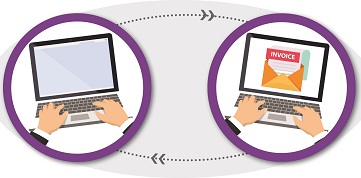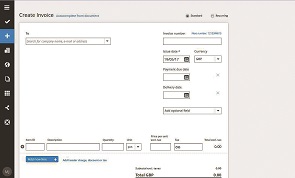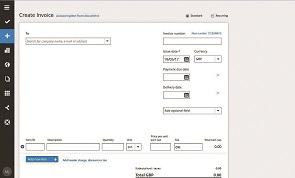Feature / Virtual invoicing – the real deal
The NHS has moved slowly to embrace
e-invoicing, in some cases getting only as far as receiving invoices by email. But a push is now on to make a reality of e-invoicing.

Four years ago, when health secretary Jeremy Hunt committed to a paperless NHS, he wasn’t primarily thinking about getting rid of paper-based invoices. The focus was more on moving to paperless referrals underpinned by electronic patient records. But with the NHS processing perhaps as many as 15-20 million invoices each year, modernising trading systems was still an important component.
The original ‘paperless’ target date of 2018 may now have been recognised as ‘unachievable’. But turning the NHS onto e-invoicing remains a key goal, albeit one without a specific deadline. Some solid progress has been made, but there is significant potential for improvement. And with all NHS bodies facing pressure to reduce corporate and administration costs or refocus finance department support on more value-added activities, some believe moving to e-invoicing is an obvious step.

Commissioners alone process some 2.8 million invoices each year, received from NHS and other providers, other commissioners and suppliers. This number goes up again when you factor in invoices from GPs, received through the Exeter IT system.
John McLoughlin, senior finance lead for financial accounting and services at NHS England, says using NHS England as an example offers a snapshot of the service’s progress in getting its invoicing out of the wastepaper business.
Overall, the percentage of invoices received electronically by NHS England has risen from 2% to 37% in the past two years.

Considering intra-NHS transactions only, of 4,000 invoices received from NHS providers in March, about one in five were from the providers using the finance and accounting service delivered by NHS SBS. With this service provided en masse to all commissioners as part of the integrated single financial environment, these SBS trust invoices are all dealt with ‘electronically’ within the same system.
Of the other trusts, Mr McLoughlin says, just over 40 are at or close to 100% e-invoicing. But more than half of all providers rely completely on paper and the post.
‘The assumption would be that these providers are issuing all their invoices in paper format and probably receiving invoices from their service providers and suppliers as paper documents too,’ says Mr McLoughlin.
The direct costs in postage should be enough to persuade them to change their approach, he says. But there are clearly significant other benefits for NHS providers and their suppliers moving to e-invoicing. Some research suggests that e-invoicing could generate savings of more than 50% per transaction for both suppliers and customers.
With a national lower cost quartile cost of £6.75 to process an accounts receivable invoice (according to recent NHS Improvement benchmarking work on corporate services costs) and £2.16 for an accounts payable invoice, this looks like a potential win-win for both providers and commissioners.
‘Even saving just £1 per invoice on the 2.8 million invoices received by commissioners would save nearly £3m,’ says Mr McLoughlin.
Tradeshift deal
NHS SBS entered a deal with e-invoicing system provider Tradeshift in 2014 and NHS England says providers should at least be thinking about using this system – or an equivalent e-invoicing system – to invoice their NHS commissioners. The NHS standard contract requires providers to ‘use all reasonable endeavours’ to submit all invoices electronically, either using the Tradeshift system or an alternative PEPPOL-compliant system. (PEPPOL is the messaging standard adopted for procurement in the NHS.) But it stops short of making it compulsory.
Despite this encouragement, according to NHS SBS, just 87 NHS bodies are currently sending invoices using Tradeshift.
Under the deal arranged by NHS SBS, using the Tradeshift system to invoice commissioners is free for providers and suppliers – they aren’t charged per invoice, as with some invoicing systems – and all commissioners have automatically been set up with an account.
Mr McLoughlin says signing up is similar to using social media. An organisation opens an account and then searches for an organisation it wants to send an invoice to and makes a connection request. Once this is accepted, the organisation is good to go.
Under the traditional process, it could take up to 10 days from raising an invoice to it appearing on the payer’s system – by the time the invoice has been posted (often second class), sorted and scanned, and allowing for weekends. But an e-invoice is on the commissioner’s system the same day and can only be sent if pre-send validation checks are met. Providers can then monitor where the invoice has got to in the payer’s process – cutting out the need for ‘Have you got my invoice?’ calls, the most frequent question asked of finance transaction teams.
Mr McLoughlin believes e-invoicing is a ‘no-brainer’. ‘Why is someone generating an invoice electronically to convert into paper, when the recipient wants an electronic copy,’ he asks. ‘All the additional steps of first creating a paper copy and then converting it back to paper incur additional cost and time.’
NHS England has been encouraging clinical commissioning groups to adopt e-invoicing with providers with variable success. The range extends from CCGs where just 7% of invoices are received electronically up to 60%. South Kent Coast CCG is one of the CCGs towards the top of this league table of e-invoicers.
Edward Andrews, finance manager at the CCG, says the switch has cut ‘at least two weeks from processing times’ compared with previous paper-based transactions. Following a series of visits by Mr Andrews, all local GP practices have opened accounts and started submitting e-invoices and other local CCGs had also made good progress with GP sign-up.
GP practices range from multi-GP units to single-handed practices, with varying levels of IT and existing invoices raised in a mixture of Word, Excel or accounting packages.
But the effort was deemed a good investment in terms of supporting GPs, ensuring they were paid on time and in a more transparent way. However, the CCG has made less progress with its NHS providers and other suppliers.
West Kent push
West Kent CCG – with 38% of its 25,000 invoices received electronically – is also in a virtual invoicing top five. It has specifically targeted GP practices and continuing healthcare providers, succeeding in getting all its 61 GP practices onto Tradeshift and, with support from its local commissioning support unit, two thirds of its continuing healthcare providers.A spokeswoman for the finance team agrees that it can be hard work up front in supporting providers to adopt the e-invoicing process. But she says that providers really see the benefits. ‘We’ve had lots of compliments – they see it as more straightforward, they avoid the printing and postage costs and they can see where their invoice is in our organisation,’ she says.
For the CCG, its commissioning support unit and SBS, the pay-off is in a ‘total elimination of scanning errors; standard, clear and concise invoices; and fewer queries’.
The CCG has also used the process to encourage more consolidation of invoices, reducing the total number of invoices being submitted each month.
West Kent has also made less progress with its main acute and mental health providers and suggests that it would appreciate more support from NHS SBS and system leaders on this side.
There is a good argument for trusts being encouraged to move to e-invoicing for all their commissioners, rather than changing their process one CCG at a time.
Mr McLoughlin says talks are underway with NHS Improvement on this issue and he implies that the current encouragement in the standard contract could become a requirement in future. This could mean all provider-commissioner invoices having to be submitted electronically by the end of 2018/19 financial year – with a longer term target for all NHS transactions, NHS SBS accepts it is well placed to support adoption of e-invoicing. Clearly, its current focus is on promoting use of Tradeshift, but it says that commissioners and providers using Tradeshift should be able to receive invoices from other e-invoicing systems as long as these systems are PEPPOL-compliant.
While CCGs are best placed to encourage adoption among their local GP practices and care homes, SBS accepts it has a role in convincing NHS trusts and the service’s main suppliers to make the switch to e-invoicing.
Rather than dealing with individual cases – suppliers to a specific customer, for example – it has looked to maximise its reach. So it has worked with shared systems provider NEP, which has some 40 customers, to support the development of an interface to the Oracle finance system. There are also plans to work with the Capita-supported Integra financial system users.
Supplier target
On the supplier front, NHS SBS has to date targeted its 100 biggest suppliers submitting invoices (by value), succeeding so far with around 70 of them. In total, some 7,500 suppliers are sending invoices to NHS SBS via Tradeshift – about a quarter of all received invoices.
But with about 125,000 suppliers on SBS’s list of suppliers, there is a long way to go. And some of the work signing up suppliers will have to come from trusts and CCGs themselves.
Plymouth Hospitals NHS Trust was praised in Lord Carter’s report on productivity in acute hospitals for making ‘good use of e-ordering and invoicing facilities to reduce staff time in both pharmacy and finance departments’. As a customer of NHS SBS, it uses Tradeshift, which means invoices for commissioners are effectively dealt with in the SBS system.
But it has also looked to move to e-invoicing more broadly. Some 23% of 90,000 invoices a year sent to the trust are now coming through Tradeshift.
Deputy director of finance Alex Keast says this means invoices get to SBS a lot quicker and are much more likely to go to the right place. Validation is also easier. Getting suppliers to use the system has involved encouragement by the trust and SBS – though the trust probably carries more weight given that it is the one directly dealing with suppliers and placing the orders. He also says some suppliers see limitations with the system and how it can integrate with existing invoicing processes.
Mr Keast accepts that many of the benefits are for SBS, as the trust’s transactional service provider. It sees reduced queries and faster turnaround, although if SBS can reduce costs that should enable it to enhance service levels or reduce costs in future contracts. However, moving to e-invoicing is a key part of its overall strategy for e-procurement, as a pilot site for the Scan4Safety GS1 bar code scanning project.
Leeds Teaching Hospitals NHS Trust runs its accounts receivable and payable functions in-house with systems provided by shared systems provider NEP. Until two years ago, all invoices for commissioners were raised in the Oracle system, printed out and put in envelopes for posting. Switching to Tradeshift in 2015 eliminated the printing part of this process, although invoice details still had to be keyed into the new system. An interface has now been built, enabling the Oracle details to be imported into Tradeshift.
‘It’s helped us with cash management and cash forecasting,’ says David Hay, the trust’s head of financial services. ‘When we had paper invoices, our treasury people were going into accounts receivable and asking when payments were expected and if we could chase payments. Now we have a report that says with 99% accuracy that an invoice will be paid on a particular date.’ (Tradeshift will show an invoice has been approved for payment and the trust knows the dates its commissioners typically pay on.)
At the moment, the trust is using Tradeshift to send invoices to commissioners and any providers that are customers of SBS. The trust is keen to explore the potential for e-invoicing within accounts payable for invoices sent by the trust’s suppliers – although Mr Hay says it would need to understand more about the costs it might incur under this approach.
The potential is significant. The trust receives about 220,000 invoices a year. While 100,000 of these are pharmacy related, dealt with by the pharmacy department and brought into the finance system as a pre-approved e-batch, the other 120,000 are for the provision of more general goods and services. Many are submitted as an email attachment, rather than posted. And while an NEP provided system allows these invoices to be dragged into the Oracle system – avoiding rescanning – the details still have to be rekeyed.
Moving to true e-invoicing – with invoice details being taken directly into the Oracle system – could enable members of the accounts payable team to be redeployed onto more value-adding work. For example, with accounts receivable staff spending less time manually raising invoices, they can spend more time on credit control. This has led to significant reductions in 90-day debt in each of the past two years.
Mr Hay thinks that reducing some of the manual activity currently required in accounts payable – rekeying invoices into the system – could enable a similar rebalancing of efforts.
NHS SBS is in fact set to launch a new e-commerce platform called Edge for Health later this year with technology company Virtualstock. Stephen Sutcliffe, NHS SBS director of finance and accounting says this is aimed at revolutionising the way NHS organisations purchase goods and services. ‘To ensure the NHS can benefit now from the efficiency savings already available, the immediate priority must be to increase the uptake of e-invoicing by providers and suppliers,’ he said. ‘Looking further ahead, the Edge for Health will deliver a retail-standard online platform that incorporates e-invoicing as just one part of a fully digitalised procure-to-pay solution.’
It may not mark a major step forward in delivering a paperless NHS, but delivering e-invoicing across the whole NHS would be a solid contribution towards modernising the NHS accounts payable and receivable processes. Given the current pressure to reduce costs and release staff for more value-adding activities, the hope is that the next year will see a further acceleration in uptake.
Related content
The Institute’s annual costing conference provides the NHS with the latest developments and guidance in NHS costing.
The value masterclass shares examples of organisations and systems that have pursued a value-driven approach and the results they have achieved.